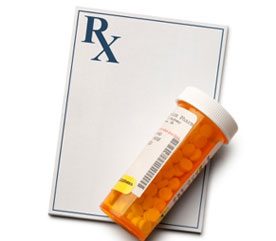
Back in 2009, when I was a graduate student, I was studying late at the University of Western Ontario and suddenly realized that my prescription for anticonvulsant medication had to be refilled. One problem: I was going to Toronto for holidays the next day. I have epilepsy and without medication I am prone to seizures, during which I collapse and thrash violently. They last only a few minutes, but they’re not pretty.
I still had a week’s worth of medicine, but transferring the prescription to a Toronto pharmacy and then back again to London, Ont., is a big headache. So I called my regular London pharmacy to let them know I was coming. I was hoping the little stapled bag would be ready when I arrived.
No such luck. I sat down beside the dispensary at the back of the store and waited. When I was finally called over to the counter, the pharmacist greeted me with a concerned sigh. “Oh, I never like giving this one out.”
“Really? What’s wrong with it?” I asked. I had taken Keppra for years and had never suffered anything worse than a little sleepiness in the morning. “We’re out of the brand-name,” said the pharmacist, “so we’re giving you the generic version.” He told me he was an epileptic and was taking Keppra himself. He had recently switched to levetiracetam, a generic version of the drug, because it was cheaper. On average, generic drugs cost 60 per cent less than the brand-name drugs they are designed to replace. But soon after he made the switch, the pharmacist said, he experienced several auras-sensations that often signal an impending seizure-and was unable to come to work.
When he switched back to Keppra, things returned to normal. I dismissed the pharmacist’s warning because I’ve found that everyone’s an expert. I’ve seen a slew of neurologists, consulted a bunch of GPs and have been to several epileptologists. Every one of them has a different explanation for the seizures and has recommended different courses of treatment. And anyway, why would Health Canada approve a generic version of Keppra if it didn’t work?
One week later, in the lead-up to New Year’s Eve-a period in which I had been dutifully taking my meds-I could tell something was off. I was on the couch when it happened. Once I realize I’m about to have a seizure, it’s already too late to do anything. All I can do is hope that I regain consciousness afterwards. In the seconds afforded to me before it hit, I remembered the London pharmacist denouncing the generic anticonvulsant he had dispensed.
I lay there helpless, convulsing and unable to draw another breath, as 100 billion neurons fired simultaneously inside my head.

Generic drugs are immensely popular in Canada, where they account for about 57 per cent of all prescriptions. Intended to have the same pharmacological effect as brand-name drugs at a fraction of the price, they have proven indispensable to Canadians.
According to the Canadian Generic Pharmaceutical Association, the generic pharmaceutical industry saved Canada’s health-care system over $2.6 billion in 2010 alone. More affordable generic drugs have likely improved and saved the lives of millions of Canadians.
However, over the last five years neurologists and pharmacologists have presented data to support one of their most pressing concerns: that far from being “just as good,” generic neurological drugs may deliver medicine differently than their brand-name counterparts. The problem, according to neuropharmacologist Dr. Frank Vajda, is a pharmacological double standard.
“The proof for drugs to be accepted as generically equivalent,” says Vajda, “is not comparable to the proof of safety required to have a drug initially registered.”
This doesn’t mean generic drugs are unsafe; only that these competing thresholds for proof can cause serious and potentially dire complications for patients switching to generic versions of brand-name drugs. At the outset, it should be said that this applies only to some drugs, including certain anti- depressants, immunosuppressants (used to prevent organ rejection), drugs to treat cardiac arrhythmia and my own medication: anticonvulsants.
Switching from brand-name to generic is common practice. Sometimes the substitution is automatically triggered by provincial guidelines or by drug plans that require patients to opt for the more inexpensive generic version when it appears on the market.
Sometimes pharmacists think they’re doing the patient a favour by giving him or her the chance to save some money. Or, as in my case, sometimes the pharmacy is temporarily out of the brand-name.
Unfortunately, these substitutions can happen without the patient or pharmacist knowing that an element of risk might be involved-risk rooted in the very approval process that allows generic drugs to be so affordable.
Generic drugs may be huge cost savers overall for Canadians, but as an example of what can happen when patients aren’t properly informed of the hazards of switching meds, I offer you Exhibit A: me.
The medical story of my own disorder starts with pharmaceutical companies, the prime movers in developing medication for brain conditions such as epilepsy. These drugs take years to develop and can cost hundreds of millions of dollars to perfect. It’s meticulous work-and only large companies have pockets deep enough to do the research.
When it comes to epilepsy, those deep pockets are necessary: Only a perfectly balanced drug can be effective in the delicate and volatile environment of the brain.
For the inventor’s investment and hard work when developing new kinds of drugs, Canadian patent law awards the creator the exclusive right to produce and sell the drug for 20 years after the patent application is filed.
Generic-drug companies can step in the moment a patent expires. Copycat versions of brand-name drugs have a shorter, considerably less expensive path to approval. They don’t need to repeat the costly safety and efficacy trials that the drug’s creator already conducted. Instead, they simply need to show how the generic drug performs compared with the original. Generic-drug manufacturers are also able to sell their products for far less because they do not have to invest in promotion.

To be approved by Health Canada, the generic-drug company must show that its drug “contains identical amounts of the identical medicinal ingredients, in comparable dosage forms.” Sounds reasonable, but few patients know that medicinal ingredients can account for as little as 25 per cent of the volume of a pill. The rest is taken up with “excipients,” or filler-inert substances used to bind together the contents of the pill.
Health Canada stipulates that generic drugs aren’t required to include “the same non-medicinal ingredients.” Generic-drug companies, in other words, are free to use whatever chemical compound they like as filler, provided it is safe and that the drug contains an identical amount of medicinal ingredient as the brand-name version.
But this is where it gets tricky, ac- cording to Terence Ozolins, a pharmacologist at Queen’s University. He explains that although they have no medicinal properties, excipients can affect to what extent, and how quickly, a drug is absorbed in the body. “Together, these factors may significantly influence the therapeutic concentrations achieved,” he says.
How big a difference can this make? According to Health Canada, a generic drug has to demonstrate a therapeutic equivalence only within a particular range of its brand-name counterpart-it can be slightly weaker or slightly stronger. Ozolins, however, argues that this standard may not be “stringent and nuanced enough” for today’s generation of slow-release drugs and fine-tuned neurological drugs. Hence the danger: generic drugs going to market that may not behave similarly enough to the brand-name versions they’re intended to replace.
Unsurprisingly, recent studies that call into question the therapeutic equivalence of generic drugs are spurring responses from the makers of these drugs. Bob Billings, executive director of the Generic Pharmaceutical Association, argues that “generic drugs have come to be widely accepted as the therapeutic equivalents of brand-name drugs, and the resultant savings have totalled hundreds of billions of dollars.”
Billings believes many patient groups are sincere but misguided in their concerns about generic drugs. “For some patients, switching between medicines needs to be monitored,” he admits. “But any difference between the generic and brand versions of the same drug is no greater than the difference found between two manufacturing batches of the same brand-name drug.”
Dr. Pierre Blier disagrees. Blier, who holds Canada’s Research Chair in Psychopharmacology, says that companies perform physicochemical tests on every batch of drugs they manufacture. These tests, which monitor a drug’s physical properties, such as solubility, have yielded troubling results when applied to certain generic drugs. “In a 2004 study that examined various batches of a brand-name and generic anticonvulsant, researchers observed drastically different dissolution rates for the generic when com- pared with its brand-name,” says Blier. “Another study, from 2006, looked at the cardiovascular drug carvedilol. The brand-name drug met all the criteria set for physicochemical testing-drug content, tablet hardness, dissolution and purity,” ex- plains Blier. “But 17 of the 35 generic drugs failed to meet at least one of those requirements.”
Where is the funding for all these studies coming from? Many people, including Billings, say it would be naïve to think the business interests of big pharmaceutical companies aren’t sometimes involved in casting doubt about the safety and efficacy of generic drugs.
Ozolins points out there is self-interested funding on both sides of the debate: There are also generic drug companies funding studies that find there is no significant therapeutic difference between generic and brand-name drugs. None of the results are wrong, strictly speaking; it’s just that the way a study is designed can greatly influence the outcome. “[Therapeutic equivalence] is still a matter of much controversy,” says Dr. Michael Privitera, medical director at he University of Cincinnati. Take two recent studies that looked at a generic anticonvulsant called phenytoin (PHT), a copycat version of Dilantin-currently one of the most prescribed anticonvulsants in Canada.
Some doctors say there is no problem with phenytoin. But a 2008 study published in the medical journal Neurology ranked it as the most commonly cited anticonvulsant that failed to provide sufficient protection in the treatment of epilepsy. And a 2004 study from Neurology-in which eight patients who switched to a generic version of Dilantin suffered seizures-had already concluded that “substitution between brand and generic PHT or other drugs with a similar profile should not be allowed without alerting the physician.”
While it is true both studies were funded by pharmaceutical giant Glaxo-SmithKline, they were also conducted by the Department of Neurology at the University of Rochester Medical Center and the College of Pharmacy at the University of Minnesota-two reputable institutions.
And in 2007 the journal Epileptic Disorders reported on a case where a generic drug was stronger than its brand-name counterpart. In Italy, a woman’s prescription was switched from the anticonvulsant Tegretol to its generic equivalent, carbamazepine.
Days later, she landed in the hospital with carbamazepine intoxication. Blood tests showed abnormally high amounts of the drug in her system- nearly four times what it was on Tegretol. Troubled, the American Academy of Neurology has issued a caveat:
“For anticonvulsant drugs, small variations in concentrations between brand-names and their generic equivalents can cause toxic effects and/or seizures when taken by patients with epilepsy.” The British Epilepsy Association seems to share the concern. It is now campaigning against a proposal that pharmacists automatically substitute the generic versions of prescribed drugs.

But in Canada the issue is barely on the radar. Canadian epilepsy organizations aren’t campaigning against automatic generic-drug substitution, and these groups’ discussions about the possible hazards of unmonitored switching between brand-name and generic drugs have led nowhere. Suzanne Nurse, the executive director of the Canadian League Against Epilepsy, confirms that “at the moment, there has not been a statement or position taken by any of the national epilepsy associations.” after my seizure in December it took me weeks to get better. My usual recovery time is just a few days. But now I felt as if another seizure could paralyze me at any moment. The subway was off limits. Escalators were out of the question. Even a shortcut I often took to get home was now out of bounds. I was terrified of collapsing when alone and having a seizure in a remote area, maybe being left for days.
When you’re prone to random and uncontrolled blackouts, you begin to consider and even plan for the worst.
In late January I managed to get an appointment with my neurologist in Toronto, Dr. Maureen Shandling. I explained what had happened in the last month, including my exchange with the pharmacist in London. Shandling showed me copies of my prescriptions that clearly stated “No substitutions.” She explained she had done this to ensure I was always receiving the same drug manufactured by the same company.
When I left the doctor’s office, I went directly to the pharmacy and refilled my prescription with Keppra. Within days I was feeling better. Yet the experience has left me profoundly unsettled. I have lived with a seizure disorder for 15 years and some of my closest friends have no idea. Maintaining this seemingly healthy alter ego has been hard work. Epilepsy is inherently unpredictable. Stress, alcohol, caffeine, fever and poor diet are just a few seizure triggers.
Even with my careful foresight and meticulous planning, it’s impossible to address every potential contributing factor. Taking my daily anticonvulsant medication has always been one element that I knew I could completely manage, and which involved no variance.
But the reality-that the effect of anticonvulsant medication fluctuates when switching from brand-name to generic, or from generic to generic- is something I never considered. I would like to believe that generic drugs will always help me the same way as brand-name ones have: It’s what should allow me to put my trust in them. I still might consider taking generic drugs, under doctor’s orders. But for me, for now, that trust has been momentarily shaken.